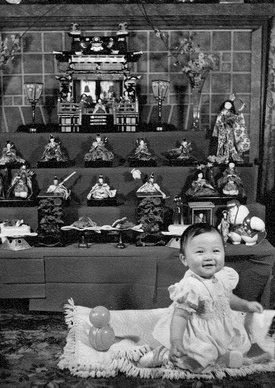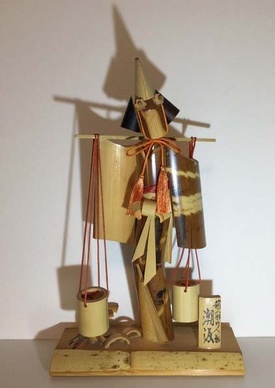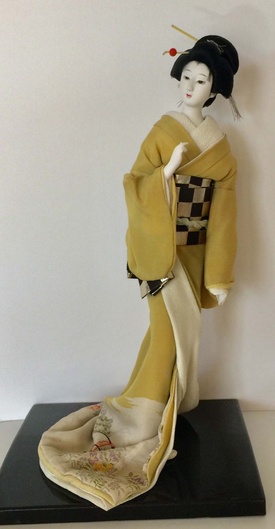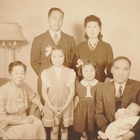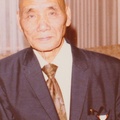The first gift I remember receiving from Jichan and Bachan was a gift of Japanese culture, the celebration of Girls’ Day or Hinamatsuri, a Japanese holiday celebrated every year on March 3rd. I “remember” my first Girls’ Day now because of photographs taken by my uncle, Shosuke Sasaki. Though not a professional, Uncle Shosuke was an expert photographer and he took a picture of me at about nine months of age in front of a Girls’ Day display in March of 1941. Jichan and Bachan were prospering around that time and even took a cruise to Japan. They were able to afford an elaborate Girls Day set.
Suddenly, everything changed. At the end of 1941, after Imperial Japan bombed Pearl Harbor in Hawai'i on December 7, Japan and America were at war. President Roosevelt signed Executive Order 9066 on February 19, 1942, which authorized the exclusion and forced removal of Japanese Americans from government-designated areas of the West Coast of the United States. By Girls’ Day 1942, our family knew that we would be forced to move from our home in South Park, Seattle. From that moment on, our lives were divided into the time before Executive Order 9066, when Jichan and Bachan prospered and achieved the “American Dream” and the time after “Camp” (a term I use to refer to Camp Harmony, WA and Camp Minidoka, ID) when the family’s “American Dream” turned into a nightmare. I have no memories of the time before Camp. Our “American Dream” which existed before “Camp” lives and is remembered only in the photographs that Jichan and Uncle Shosuke took before Camp.
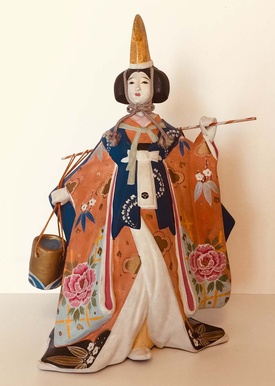
I do remember that Jichan put the elaborate display of dolls up on Girls' Day for many years after we returned to our South Park home from Camp Minidoka in the fall of 1945. The Girls' Day dolls had been stored in the basement of our home and were severely damaged during the almost four years we were incarcerated. I remember Bachan trying to repair the faces of the damaged dolls and Jichan setting up the display shelves. A beautiful deep red fabric covered the shelves and then the dolls were placed on the red fabric. By then, I was old enough to help set up the display but only a few of the pieces, especially the ceramic ones, were undamaged. Still, we enjoyed the display and observed this beautiful Japanese custom for many years. Jichan and Bachan kept the culture of Japan alive for their grandchildren. Today, I have a beautiful ceramic doll from the Girls’ Day collection displayed in a curio cabinet filled with some of my favorite things.
My first American doll was a Christmas gift from Mother and Father, given to me when we were in Camp Minidoka. Baby sister Louise also received a doll that year. On Christmas morning, I woke up before my baby sister, so I had my pick of the two dolls, which Mom and Dad must have purchased on an outing to Twin Falls, Idaho. They had to get a special pass from the Camp Minidoka authorities to exit past the guard towers around Camp and go to Twin Falls, which was about fifty miles away by train. There was no access to Japanese dolls during WWII, so all our dolls from the time we were in Camp were American dolls. Some of these early dolls survived the trip back to Seattle, but one unfortunate doll did not survive my carelessness. I had left it outdoors, where rain caused her plaster face and head to crackle. Another doll was lost in the fields around our South Park home. Later, it was unearthed from a dirt pile.
Around middle school, I began to collect Madame Alexander dolls. I took much better care of them than I had of the dolls I received as a toddler. The first Madame Alexander doll I got for Christmas was “Nina Ballerina” and she had the face of Margaret O’Brien, who had played the role of a child ballet student in “The Unfinished Dance.” I remember seeing this 1947 movie, which made a great impression on me. Later, I received the “Amy” Madame Alexander doll. Margaret O’Brien played the role of “Amy” in an early film version of Louisa May Alcott’s beloved book, Little Women, a lifelong favorite of mine.
As my sister and I grew older, Jichan stopped putting up the Girls' Day display. My sister and I both married and moved away from home. By then, Mother and Father had reestablished the “American Dream” for the family, building on the businesses and the property that Jichan had acquired. All four children graduated from a college or university and sought their own version of the “American Dream.”
Jichan passed away quite unexpectedly in 1975 and Bachan died of a broken heart a few months later. I returned home to South Park to help clean up the old home and property in South Park, including the boiler house, to ready it for sale. My interest in Japanese dolls was rekindled when I opened a chest in a bedroom of the boiler house. It was filled with beautiful bamboo dolls and tiny but exquisite items of carved bamboo, acquired by Jichan and Bachan on one of their trips to Japan, probably to give as omiyage, but never used. For me, it was like finding a treasure chest. Mother let me take whatever I wanted. I gave the most beautiful of the dolls to my sister-in-law, because I had no easy way of transporting them to my home in Tucson. My sister-in-law, in turn, gave them to her granddaughters, who treasure them still. I kept this doll and it is in the same curio cabinet as the ceramic doll.
Yasuyo Komatsu, a house guest from Japan, recognized the bamboo doll as a type of doll produced only in Fukui-ken, the home province of Jichan’s Kaneda family. Clearly, Jichan and Bachan had bought the items in the boiler house “treasure chest” while visiting Fukui-ken. According to the information from Yasuyo, the dolls are called Echizen-take-ningyo or Echizen district bamboo dolls. These dolls were created out of special kind of bamboo which grows in Fukui-ken, around 1952, by the Fukui-ken artisans, Yasutaka Morota and his younger brother and developed into a new form of folk art by Yasutaka’s son, Reimei.
Jichan and Bachan kept a beautiful, silk-clothed doll of a maiko, or geisha-in-training, in their bedroom. I had often admired the doll. After Jichan and Bachan died, Mother gave me this beautiful doll as a remembrance of Jichan and Bachan. Although it is too tall to fit into the curio shelves with my other Japanese dolls, it still has a place of honor in my living room.
The Japanese dolls from Jichan and Bachan that I received in adulthood reawakened my interest in Japanese dolls. After retirement, I became a clay artist, and have even made kokeshi style dolls out of clay. The gifts of beautiful Japanese dolls from Jichan and Bachan have become a part of me. Girls’ Day displays and the beautiful gifts of dolls are some of the happiest memories of my childhood and a source of inspiration to this day.
© 2020 Susan Yamamura


